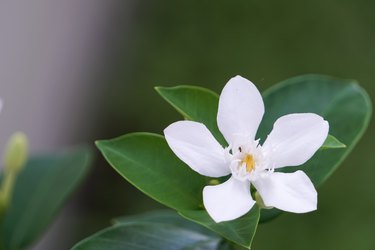
Gardenias (Gardenia jasminoides, USDA zones 7-11) are beautiful plants to keep indoors or to grow in a garden. If you have animals, you may be wondering if gardenias are poisonous to pets. Unfortunately, gardenias, like a number of other plants, are toxic to some pets, but there are ways to deter pets from eating them.
Gardenia Plant Characteristics
Video of the Day
Also called cape jasmine, gardenia is an evergreen shrub native to southern China and Japan. The evergreen has glossy, dark-green leaves that can grow up to 4 inches long, and the shrub can grow to 6 feet tall, depending on species and cultivar. Although many flowers and plants are known for their beauty, gardenias stand out because they have very fragrant white flowers that can grow up to 3 inches in diameter.
Video of the Day
Unfortunately, the evergreen shrub can only bloom throughout the year in warmer climates. In climates that dip below 60 degrees Fahrenheit, you'll only see them bloom in late spring to early summer. Gardenias can be grown as a pot plant or a larger container plant. Although they thrive outdoors and in greenhouses, you can bring them indoors. Just make sure that they are sitting in a bright area but out of the direct sun.
Are Gardenias Poisonous to Pets?
Although gardenias are beautiful accentuating plants indoors or outdoors, they are unfortunately toxic to dogs, cats and horses. If your dog, cat or horse has eaten a part of your gardenia, it may experience mild vomiting and/or diarrhea. Your pet may also experience hives.
If you suspect your pet has eaten one of your gardenias, you should call the ASPCA Animal Poison Control Center or your local veterinarian as soon as possible. They will be able to assist you and will let you know how to help your pet. Be aware, though, that a consultation fee may apply when calling the ASPCA Animal Poison Control Center.
Gardenias in the Garden
If you want to grow gardenias in the garden but you're worried that your pet might eat them, put up deterrents to keep your pets out. The easiest way to do this is by putting up a barrier like chicken wire. For gardeners who are worried that their pet might hurt itself, put up a plastic safety fence instead. If you want a more open-looking garden and don't want to put up a fence, you can also place scent deterrents for cats and dogs.
An urban legend many of us may have heard is to throw mothballs into your garden. Unfortunately, mothballs are not only toxic to animals but to humans as well, so don't put them in your garden.
Scent Deterrents for Pets
Spicy substances, coffee grounds and bitter orange sometimes deter dogs from coming into the garden. Try to spread cayenne pepper or crushed red pepper around your plants. If you want to spread bitter orange throughout your garden, you can use orange or grapefruit peelings.
For gardeners who don't want peelings in their garden, blend orange or grapefruit rind with water in a blender. Spread this mixture around your garden. Be careful that this mixture isn't super strong and don't pour it directly on your plants.
Cats don't like strong-smelling herbs like sage and rosemary, so if you like the smell of them, plant them throughout your garden. They don't like coffee grounds either, so you can spread them throughout your garden too.